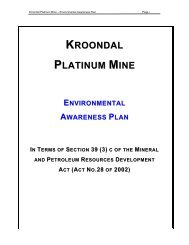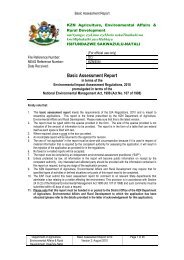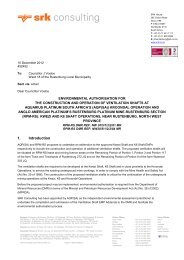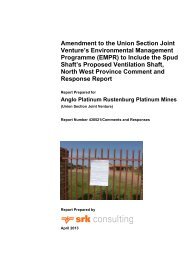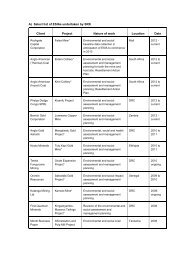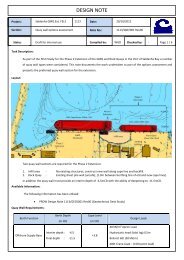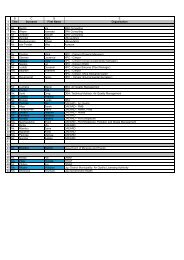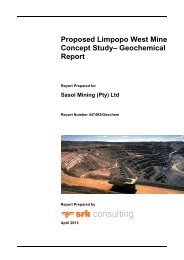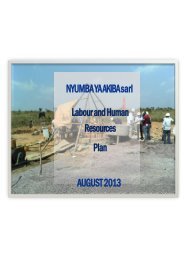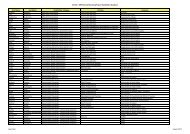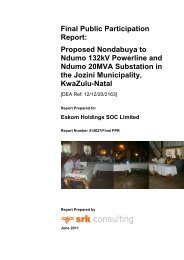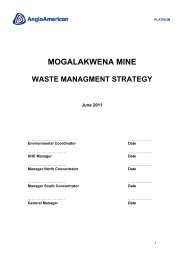Final Scoping Report for the Proposed ... - SRK Consulting
Final Scoping Report for the Proposed ... - SRK Consulting
Final Scoping Report for the Proposed ... - SRK Consulting
You also want an ePaper? Increase the reach of your titles
YUMPU automatically turns print PDFs into web optimized ePapers that Google loves.
<strong>SRK</strong> <strong>Consulting</strong>: Project No: [Abbreviated title] Page 70<br />
For all <strong>the</strong> specialist studies, a common, defensible method of assessing significance will be used, which will<br />
enable comparisons to be made between risks / impacts, and will enable authorities, stakeholders and<br />
Kalumines to understand <strong>the</strong> process and rationale upon which risks / impacts have been assessed.<br />
The first stage of risk / impact assessment was <strong>the</strong> identification of environmental activities, aspects and<br />
impacts. This was supported by <strong>the</strong> identification of receptors and resources, which allowed <strong>for</strong> an<br />
understanding of <strong>the</strong> impact pathway and an assessment of <strong>the</strong> sensitivity to change. The definitions used in<br />
<strong>the</strong> impact assessment are given below:<br />
An activity is a distinct process or task undertaken by an organization <strong>for</strong> which a responsibility<br />
can be assigned. Activities also include facilities or pieces of infrastructure that are possessed<br />
by an organization.<br />
An environmental aspect is an „element of an organizations activities, products and services<br />
which can interact with <strong>the</strong> environment‟ 29 . The interaction of an aspect with <strong>the</strong> environment<br />
may result in an impact.<br />
Environmental risks/impacts are <strong>the</strong> consequences of <strong>the</strong>se aspects on environmental<br />
resources or receptors of particular value or sensitivity, <strong>for</strong> example, disturbance due to noise<br />
and health effects due to poorer air quality. Receptors can comprise, but are not limited to,<br />
people or human-made systems, such as local residents, communities and social infrastructure,<br />
as well as components of <strong>the</strong> biophysical environment such as aquifers, flora and palaeontology.<br />
In <strong>the</strong> case where <strong>the</strong> impact is on human health or well being, this should be stated. Similarly,<br />
where <strong>the</strong> receptor is not anthropogenic, <strong>the</strong>n it should, where possible, be stipulated what <strong>the</strong><br />
receptor is.<br />
Receptors comprise, but are not limited to people or man-made structures.<br />
Resources include components of <strong>the</strong> biophysical environment.<br />
Frequency of activity refers to how often <strong>the</strong> proposed activity will take place.<br />
Frequency of impact refers to <strong>the</strong> frequency with which a stressor (aspect) will impact on <strong>the</strong> receptor.<br />
Severity refers to <strong>the</strong> degree of change to <strong>the</strong> receptor status in terms of <strong>the</strong> reversibility of <strong>the</strong> impact;<br />
sensitivity of receptor to stressor; duration of impact (increasing or decreasing with time); controversy<br />
potential and precedent setting; threat to environmental and health standards.<br />
Spatial scope refers to <strong>the</strong> geographical scale of <strong>the</strong> impact.<br />
Duration refers to <strong>the</strong> length of time over which <strong>the</strong> stressor will cause a change in <strong>the</strong> resource or<br />
receptor.<br />
The significance of <strong>the</strong> impact will <strong>the</strong>n be assessed by rating each variable numerically according to defined<br />
criteria as outlined in Table 3-2. The purpose of <strong>the</strong> rating is to develop a clear understanding of influences<br />
and processes associated with each impact. The severity, spatial scope and duration of <strong>the</strong> impact toge<strong>the</strong>r<br />
comprise <strong>the</strong> consequence of <strong>the</strong> impact and when summed can obtain a maximum value of 15. The<br />
frequency of <strong>the</strong> activity and <strong>the</strong> frequency of <strong>the</strong> impact toge<strong>the</strong>r comprise <strong>the</strong> likelihood of <strong>the</strong> impact<br />
occurring and can obtain a maximum value of 10. The values <strong>for</strong> likelihood and consequence of <strong>the</strong> impact<br />
are <strong>the</strong>n read off a significance rating matrix (Table 3-3), and Table 3-4 is used to determine whe<strong>the</strong>r<br />
mitigation is necessary 30 .<br />
29 The definition has been aligned with that used in <strong>the</strong> ISO 14001 Standard<br />
30 Some risks / impacts that have low significance still require mitigation



